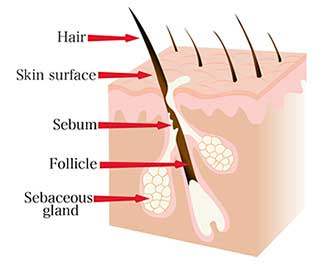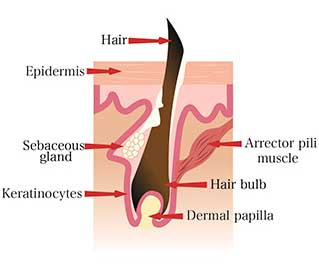Hair Anatomy
Written by Dr. Griffin

This is a simplified diagram of the skin and hair. As it illustrates, there are two main sections of the hair anatomy—the shaft and the follicle—as well as an attached sebaceous gland.

Diagram B – Hair Anatomy
Learn About the Structure and Function of Hair from the Philadelphia Area’s Dr. Thomas Griffin
Hair has many functional and aesthetic benefits. In addition to providing protection against the sun’s rays and helping to regulate body temperature, it is also a natural part of many people’s looks or a way of expressing themselves through hairstyles. Each person’s hair is unique, with the strands growing in different colors, textures, and lengths. However, underlying all of this, everyone’s hair anatomy is basically the same. The team at the Griffin Hair Restoration Center of Philadelphia is highly knowledgeable on hair anatomy. Philadelphia-area patients often seek advice from Dr. Thomas Griffin on how to take care of their hair properly to keep it healthy and well maintained. He believes that hair care starts from the inside out, and taking care of your overall health is important for supporting healthy hair anatomy.
Discover the most effective ways to counter act hair loss and learn everything you need to know about hair anatomy from the Philadelphia-based team at The Griffin Hair Restoration Center of Philadelphia. Call (215) 561-9100 or submit a contact form to request a consultation.
Hair Anatomy Basics: What Is the Purpose of Hair?
Humans have hair follicles all over the body, from our heads down to our toes. Have you ever wondered why we have hair on our bodies? Before delving into the details of hair anatomy, let’s first explore the purpose of this aspect of human anatomy.
Hair helps us to retain heat while also providing a layer of protection against external influences such as abrasion, water, and chemicals. However, the purpose of hair varies somewhat depending on which area of the body it grows. Head hair, for example, helps to regulate the temperature of the brain while also providing some cushioning for the skull. Understanding hair anatomy, from the visible shaft to the lower follicle, is important, as it helps us understand what causes hair loss and how best to prevent and treat it.
All About Hair Anatomy: What is Hair Made of and How Does Hair Grow?
We know that hair plays an essential role in society and is seen as symbol of identity, health, attractiveness, youth, and virility for men and women alike. But have you ever wondered – what is the anatomy of hair?
Many are surprised to find out that hair anatomy is a lot more complex that it seems. Hair anatomy may seem simple, with the strands on your head and body being nothing more than colored keratin, but there is much more to it going on below the skin.
Each person has around 100,000 hairs on their head, but some of these strands are shed each day. When everything is working as it should, the hairs that are shed are constantly replaced, thanks to the normal hair cycle.
“What is hair made up of?” “Where do we get hair from?” It’s likely that thesearesome hair anatomy-related questions you may have wondered about. Hair anatomy consists of two main components: the hair root and the shaft. The hair anatomy that is visible above the surface of your skin anywhere on your body is actually made up of cells that are no longer alive. These layers of cells that form a tube-like structure are called the shafts of the hair. The part of the hair anatomy that you can’t see below the surface is made up of living cells.
The hair bulb in the middle layer of skin is called the root of the hair. It is where new hairs are created and nutrients are delivered to the cells. Each part of the hair anatomy works together to support the hair growth cycle.
Hair Anatomy: The Follicle
Hair follicles are an essential part of hair anatomy. Not only do they generate the hair strands, but they keep the hair anchored to your scalp.
Follicles are essentially tiny, pocket-like holes in the skin where hairs grow. The follicle is composed of several parts that perform various functions. As can be seen in diagram B, the dermal papilla is the base of the hair follicle, containing capillaries that feed the hair cells with nutrients passed through the hair bulb. This hair bulb is the living part of the hair, fed by the papilla, and these living cells grow and multiply at a very quick rate. The cells divide every 23 to 72 hours, which makes them the fastest multiplying cells in the body. Their multiplication spurs the actual growth of hair.
The remainder of the hair anatomy is composed of an inner and outer sheath, both of which serve to form and shield the growing hair shaft. The inner shaft ends at the sebaceous gland, while the outer sheath continues up the shaft and attaches to the arrector pili muscle. The contractions of this muscle are what cause the hair to stand up on end when the body is cold, nervous, or excited.
Hair appears in many different colors—such as black, brown, blond, or red—due to the pigment cells that produce melanin in the hair follicle.
Hair Anatomy: The Sebaceous Gland
The sebaceous gland is an exocrine gland connected to the mid portion of the follicle. This aspect of hair anatomy secretes sebum, an oily or waxy substance that is important to the skin because it provides natural lubrication and waterproofing. More than one sebaceous gland may be attached to a single hair follicle, and the sebum is delivered to the surface of the skin by traveling up the hair itself. The number of glands and the amount of sebum they produce are hereditary, though generally more sebum is produced after puberty and decreases steadily with age.
Real Patient Before & After Photos
Hair Anatomy: Hair Shaft
The hair shaft is the visible component of hair anatomy that people generally think of as “hair.” It is composed of many layers of a protein called keratin, which is a very tough protein. The cells are dead, which is why hair can be safely cut and styled without pain.
The keratin in a hair shaft is naturally arranged in three layers from the innermost medulla to the cortex to the outermost cuticle. As the outermost layer, the cuticle is what is typically treated with hair conditioning, repairing, and strengthening treatments.
How to Care for Your Hair and Other Hair Anatomy Basics
Damage to your hair may occur in a variety of ways. For example, when hair is stripped of oils and moisture, it can become highly porous. Certain types of grooming habits, the chemical treatments we use on it, and environmental exposure are other factors that can be harmful to hair and eventually lead to breakage.
So what keeps hair follicles healthy? There are ways of strengthening this feature of your hair’s anatomy, keeping it healthy and allowing healthy hair to grow back if it has been damaged. Some of the best ways of maintaining healthy hair and skin include avoiding pulling out your hair, eating a healthy and well-balanced diet, managing stress, wearing equipment to prevent injuries, and protecting your hair from sun damage. Wash your hair based not on a particular schedule, but on how oily it is. For instance, people who have an oily scalp will need to wash it more frequently. Condition your hair each time you use shampoo. It’s important to get vitamins and other nutrients from our diet to maintain shiny, healthy hair and care all of our hair anatomy.
What Are Some Conditions That Affect Hair Anatomy?
Hair loss can occur due to heredity or as a natural part of aging, but damage to various parts of the hair anatomy or hair loss may also sometimes be linked to other factors as well. There may be an underlying medical condition that is damaging to hair anatomy. Some of the most common medical conditions that are harmful to hair anatomy or cause hair loss include androgenetic alopecia—also known as male pattern baldness or female pattern baldness—malnutrition, hormonal imbalances, stress, folliculitis, thyroid disease, telogen effluvium, and autoimmune disorders such as alopecia areata. There are a variety of effective techniques available in 2023 to counteract hair thinning or loss and promote healthy hair anatomy.
Hair Anatomy: Which Treatments Are Available to Address Hair Loss?
The Griffin Hair Restoration Center offers many surgical and non-surgical treatments for hair loss. Surgical solutions include male hair transplant, female hair transplant, eyebrow transplant, bread transplant and more. Hair transplants involve transferring healthy hair from an area where you have more of it to one where hair is thinning. Platelet-rich plasma (PRP) for hair loss is a non-surgical approach that involves using the patient’s own blood platelets to promote healing and new hair growth for patients who have androgenetic alopecia.
Want to learn everything you can about prevention, diagnosis, and treatment for hair loss? Find out more about how various options impact hair anatomy from Philadelphia’s Griffin Hair Restoration Center of Philadelphia. Call (215) 561-9100, or submit a contact form to request a consultation.


